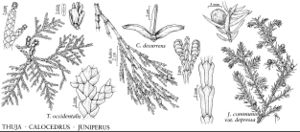Thuja
Sp. Pl. 2: 1002. 1753; Gen. Pl. ed. 5, 435, 1754.
| Taxon | Illustrator ⠉ | |
|---|---|---|
 | Juniperus communis var. depressa Thuja occidentalis Calocedrus decurrens | John Myers John Myers John Myers |
Trees evergreen, small to large. Branchlets flattened, in fan-shaped, flattened, frondlike sprays. Leaves opposite in 4 ranks. Adult leaves heteromorphic; those on larger branchlets with sharp, erect, free apices to ca. 2 mm; those on flattened lateral branchlets crowded, appressed, scalelike, lateral pairs keeled, facial pairs flat; abaxial glands present or absent. Pollen cones with 2–6 pairs of sporophylls, each sporophyll with 2–4 pollen-sacs. Seed-cones maturing and opening first-year, ellipsoid, (6–) 9–14 (–18) mm; scales persistent, 4–6 pairs, overlapping, oblong and basifixed, thin and woody, 2–3 central pairs fertile, uniformly thin or with slightly enlarged apex, remaining scales sterile. Seeds 1–3 per scale, lenticular, equally 2-winged; cotyledons 2. x = 11.
Distribution
North America, e Asia
Discussion
Two Asiatic species, Thuja koraiensis Nakai (Korean arborvitae) and T. standishii (Gordon) Carrière (Japanese arborvitae), are occasional in cultivation. They differ from the native species in having more closely spaced long-shoot leaves with shorter, spreading points.
Species 5 (2 in the flora).
Selected References
None.
Lower Taxa
Key
| 1 | Foliage dull yellowish green abaxially and adaxially; seed-cone scales minutely mucronate; e United States and e Canada. | Thuja occidentalis |
| 1 | Foliage white-striped abaxially when fresh, glossy green adaxially; seed-cone scales with evident, nearly terminal, deltate projection; w United States and w Canada. | Thuja plicata |
"with slightly enlarged apex" is not a number. "thin" is not a number. "thin" is not a number.